Vegetables come in all sorts of shapes, sizes, and colors, too! You may only be able to name a couple of different vegetables that are white in color, but did you know that there are, in fact, 13 such vegetables? And as a plus, these unassuming heroes, from garlic and onions to turnips, offer an impressive list of health benefits.
Each of these white vegetables contributes a unique flavor, vitamins, minerals, and dietary fiber to our meals. Despite their lack of vibrant color, they are anything but dull, adding variety and nutrition to our diets. So let’s dive in and get to know 13 white vegetables to add to your diet!

1. Cannellini Bean
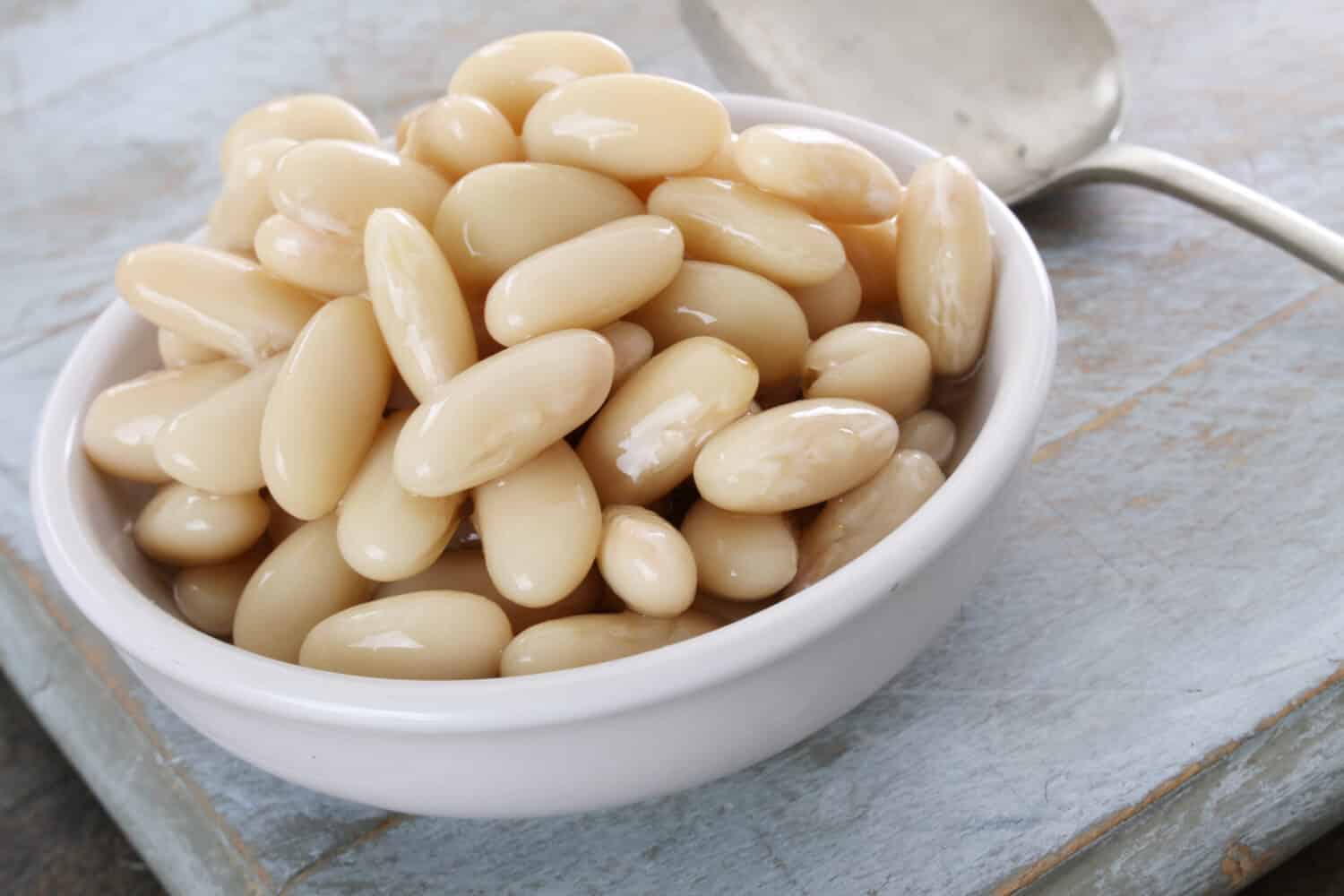
Cannellini beans are super versatile white vegetables that you can add to stews, soups, spreads, and salads.
©neil langan/Shutterstock.com
The origins of cannellini beans can be traced back to Argentina, though they are a renowned ingredient in Italian culinary traditions in today’s time. These beans belong to the kidney beans family, bearing a similar shape, and exhibit a snowy white hue in their uncooked form. Even when dried and cooked, they retain their creamy white shade.
Cannellini beans are incredibly versatile, finding their way into stews, soups, spreads, and crisp salads. Not only do they offer a delightful texture and taste, but they’re also packed with a variety of nutrients. Free of fats, they’re a rich source of dietary fiber, folate, iron, and magnesium.
In just a small serving of 1/4 cup, you can get 11 grams of protein! Introducing health-boosting foods like dried cannellini beans into your meals can aid in regulating your blood sugar levels as well.
Cannellini beans exhibit a unique characteristic when compared to other beans – they can hold their shape even after cooking. But if you wish to preserve their firmness, make sure not to overcook them.
2. Cauliflower

One of the most famous white vegetables is cauliflower.
©iStock.com/Baloncici
Cauliflower is probably one of the first vegetables that come to mind when you think of white veggies! This is a versatile vegetable that shares a family tree with cabbage. What we commonly eat is the flower or inflorescence, which people love for its palatable flavor.
So, what does cauliflower taste like? When consumed raw and unseasoned, cauliflower presents a delicate, somewhat nutty flavor that’s anything but overwhelming. In fact, it is a great addition to a raw salad. When cooked, however, cauliflower will have a natural sweetness.
The birthplace of cauliflower is the Mediterranean region. From there, it expanded its popularity to various nations, including China, India, Poland, and beyond. Today, China is the world’s top producer of cauliflower.
The components of cauliflower are vital in preventing constipation, fostering a robust digestive system, and decreasing the likelihood of colon cancer. Moreover, research suggests that dietary fiber can be instrumental in balancing the immune system and inflammation.
Interestingly, while white is the most common type, cauliflowers are available in several other colors, such as purple, brown, green, orange, and yellow.
3. Flageolet Bean

Ranging from white to light green in color, flageolet beans are common in French cooking.
©neil langan/Shutterstock.com
Flageolet beans, small, immature variants of kidney beans, exhibit a color ranging from white to light green. Predominantly grown in France, these prized beans have a soft, mild flavor, and a smooth, creamy consistency.
The beans’ creamy flavor and texture make them an excellent component in various types of meat, including lamb, chicken, and several types of fish. They often find their place in salads and stews and are a key ingredient in several famous French recipes.
Flageolets offer a mild, refined flavor that brings to mind cannellini or navy beans. As with all dried legumes, flageolet beans may be small, but they are indeed powerhouses packed with complex carbohydrates that supply energy. Moreover, flageolet beans are fiber-rich, supporting regular bowel activity. Consuming a serving of flageolet beans (approximately 7 ounces) can provide half of your daily fiber requirement.
What sets flageolet apart is its size – it’s noticeably smaller than any other kidney bean.
4. White Mushrooms
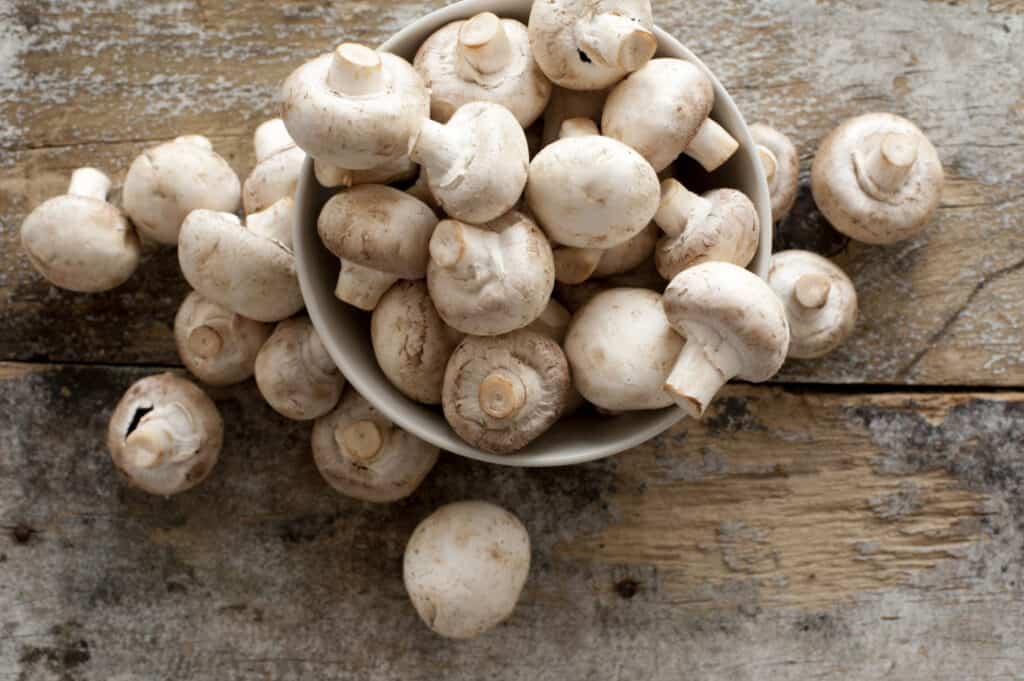
Button, or white, mushrooms have various health benefits.
©Stephen Gibson/Shutterstock.com
White mushrooms, alternatively referred to as table, common, button, or champignon mushrooms, boast a gentle flavor that nicely complements numerous recipes.
Contrary to what one might expect, the initial commercial variants of these mushrooms had a light brown color. The white variety made its appearance in 1925 when it was found amidst a cluster of brown mushrooms at the Keystone Mushroom Farm situated in Coatesville, Pennsylvania.
These white mushrooms are incredibly adaptable. You have the freedom to sauté, bake, braise, or even deep-fry them. For instance, mushrooms sautéed to perfection make a delightful addition to salads or pasta.
Filled with numerous bioactive components, white mushrooms provide multiple health benefits. These include properties that combat cancer, help in reducing cholesterol levels, and enhance gut health. Moreover, they are low in calories while providing a good amount of protein.
Here’s a fun fact about the white mushroom: it’s identical to the brown mushroom, with the only difference being their age. The brown ones are simply older versions of the same mushroom.
5. Turnip
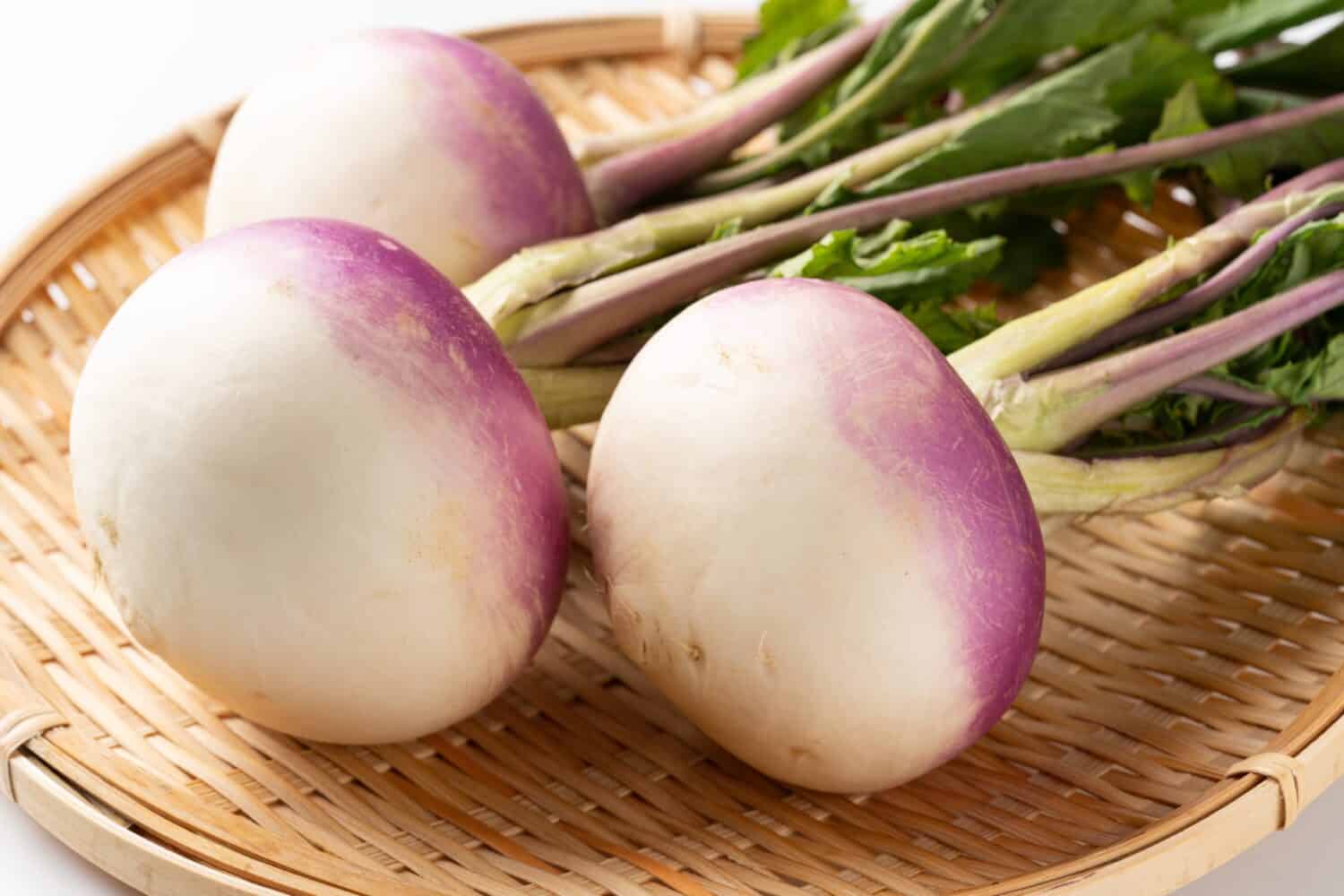
White turnips are rich in fiber and are low-calorie.
©Hanasaki/Shutterstock.com
Turnip, also referred to as white turnip, is a biennial plant from the mustard family. This vegetable has meaty roots and tender sprouting tops. It is believed that the birthplace of the turnip is central and eastern Asia, and it’s now grown across all temperate regions.
This vegetable usually exhibits a white coloration that may change to purple at the top. In terms of flavor, turnips offer a mildly spicy and intense flavor.
Turnips are fiber-rich cruciferous vegetables with a relatively low-calorie content. Consuming meals high in fiber also aids in maintaining steady blood sugar levels. The fiber in turnips can also combat constipation and support regular bowel movements for a healthy digestive system. These vegetables also contain a variety of vitamins and minerals, including vitamin C, vitamin K, folate, potassium, and calcium.
Whether it’s baked, boiled, or steamed, turnips can be prepared just like potatoes – and even beyond!
6. White Asparagus

The white asparagus has fiber, vitamins, and minerals.
©hlphoto/Shutterstock.com
White asparagus is merely green asparagus that’s been grown out of sight of the sun, buried beneath either soil or dark plastic. Due to a lack of chlorophyll, the asparagus doesn’t develop any color.
Where green asparagus boasts an earthy flavor profile, white asparagus leans towards a slightly bitter, mild taste with a sweet undertone. You can prepare white asparagus as a stand-alone side or incorporate it into salads, soups, and casseroles, among other dishes.
Packed with nutrients, white asparagus is a low-calorie vegetable abundant in fiber, vitamins, and minerals. It’s a notable provider of vitamins C, E, and K and folate. It’s also rich in antioxidants, contributing to the protection of your cells from free radical damage.
Fresh white asparagus tends to be pricier than its green counterpart, primarily because the process of harvesting and producing white asparagus requires more labor.
7. White Bell Pepper
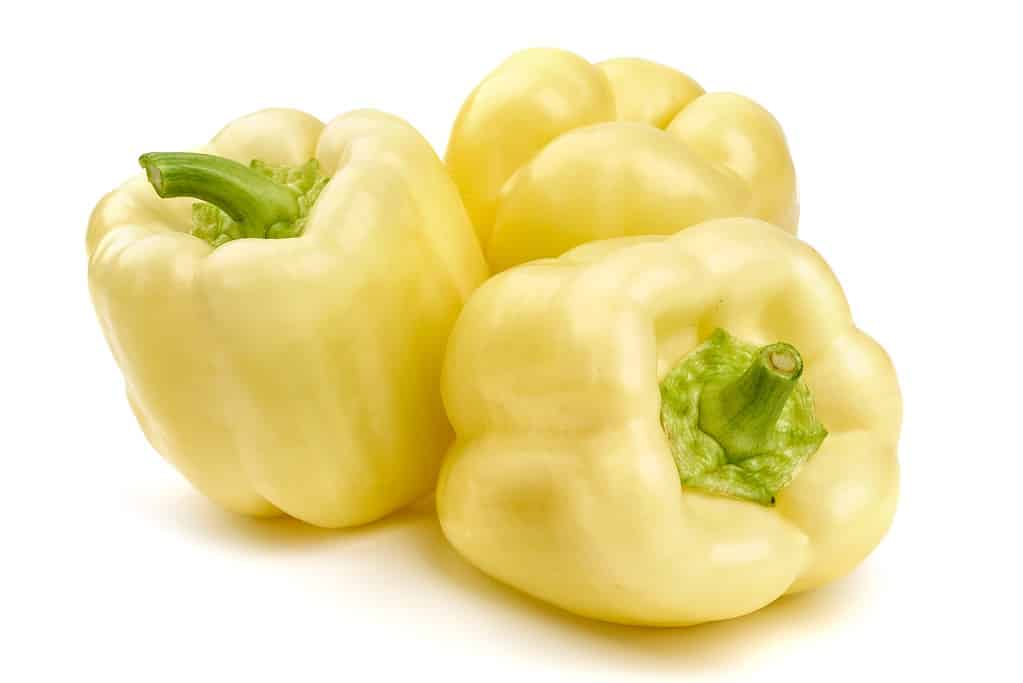
White bell peppers are technically fruits, not vegetables!
©GSDesign/Shutterstock.com
Even though bell peppers are considered and used as vegetables, they are technically fruits.
The white bell pepper has a clear white to soft yellow color and a crunchy texture with a sweet undertone. This type of pepper produces a plentiful amount of bell-shaped fruits that transition from translucent to a pale yellow when they reach maturity. You can significantly enhance a dish or salad with the addition of white bell pepper.
Enjoying a bite of white bell pepper gives you a moist crunch along with a light, sweet flavor.
Nutritionally, white bell peppers are an excellent provider of vitamin C. They also contain vitamins A, E, K, and B6. Despite their lack of pigment, these peppers still carry small quantities of carotenoids, which are beneficial due to their antioxidant and anti-inflammatory properties.
In the botanical world, white bell peppers fall under the Capsicum annuum classification. They’re an uncommon edible fruit variant that can be cultivated as an annual or perennial plant.
8. White Corn
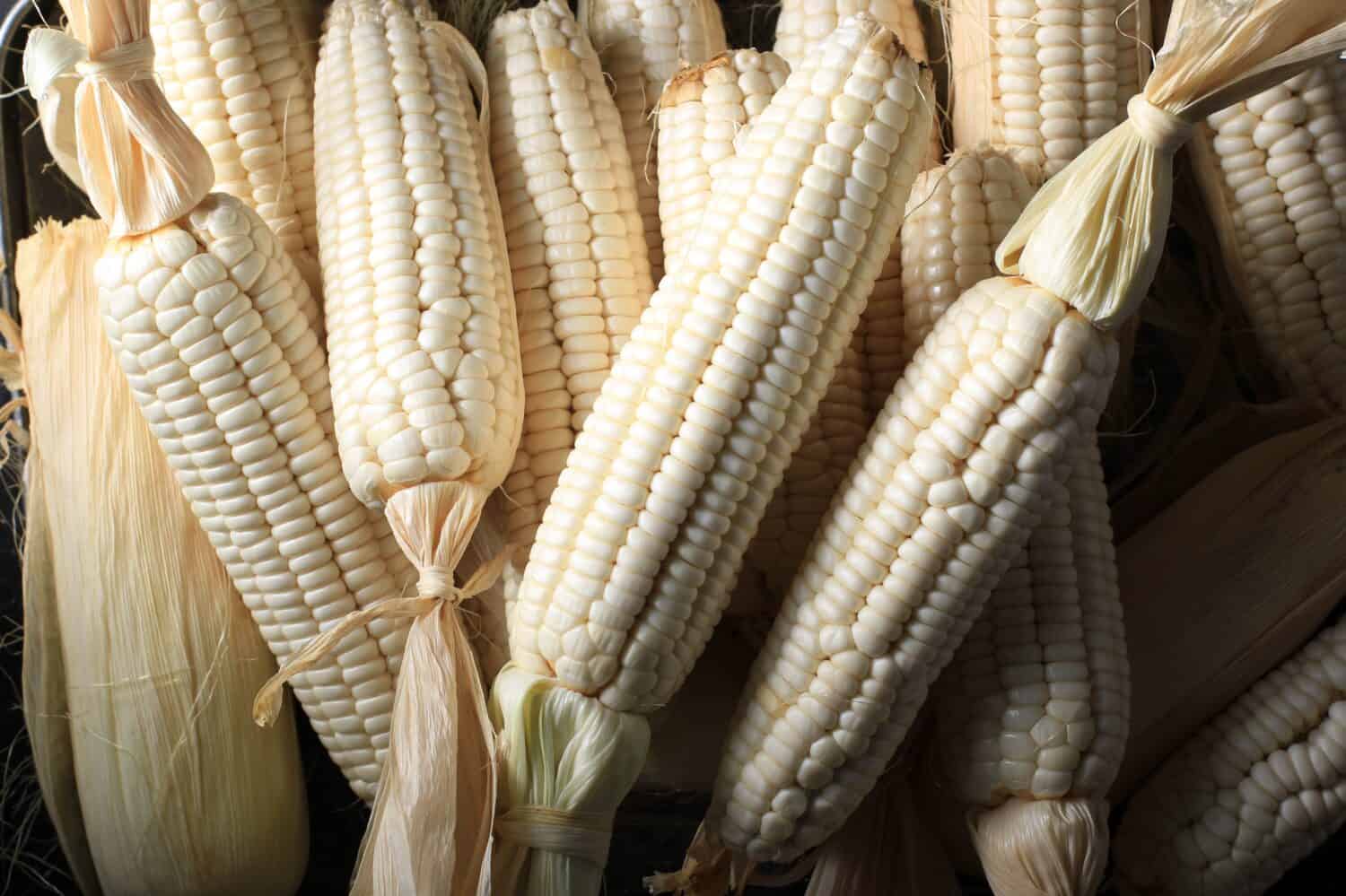
White corn is rich in fiber.
©Ika Rahma H/Shutterstock.com
Another fruit that is often treated as a vegetable is corn. White corn, also called “sweet” corn, has recognizable compact white kernels. Its length ranges from 7 to 9 inches, and it has a husk that is relatively easy to remove. One of its notable characteristics is its exceptionally sweet taste.
Ancient Mexican legends tell us that corn was bestowed upon our planet by gods, and it is a crop that sustains life.
White corn is rich in fiber, which aids in regulating bowel movements and reducing digestive problems like constipation, indigestion, and colon cancer. Additionally, it contains vitamin B and antioxidants that promote nerve health and enhance cognitive function.
This variety of corn is versatile and can be used in various culinary preparations. The kernels can also be extracted from the cob and added to salads, pureed for dips, or mixed into pasta dishes.
9. Garlic
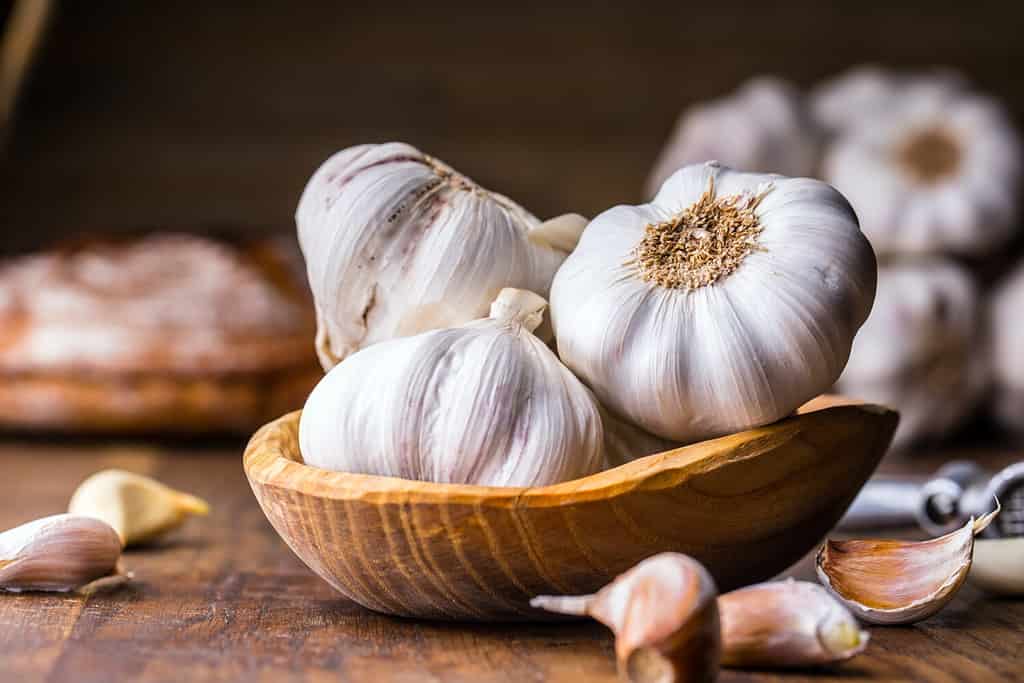
Garlic has a unique and powerful taste that can be spicy and nutty in flavor.
©Marian Weyo/Shutterstock.com
Belonging to the same family as onions, leeks, and chives, garlic is a vegetable. It typically has a pale white color but may develop blue or green hues when in contact with acidic substances such as vinegar or lemon juice over a prolonged time.
Garlic’s flavor profile is unique and powerful, tending to be more on the spicy side when raw, but once cooked, it assumes a more nutty taste. Elements like diallyl disulfide contribute to its flavor, which bears a resemblance to mustard. As garlic is dried and ground into a fine powder, its strong, fresh flavor becomes more subdued, turning it into a great spice for various dishes.
Studies have shown that regular garlic intake can reduce the levels of total cholesterol by 10 to 15 percent. Importantly, it does not affect the levels of HDL or beneficial cholesterol.
Garlic, a staple in human food for over 4,000 years, is believed to have originated in Central Asia.
10. White Onion
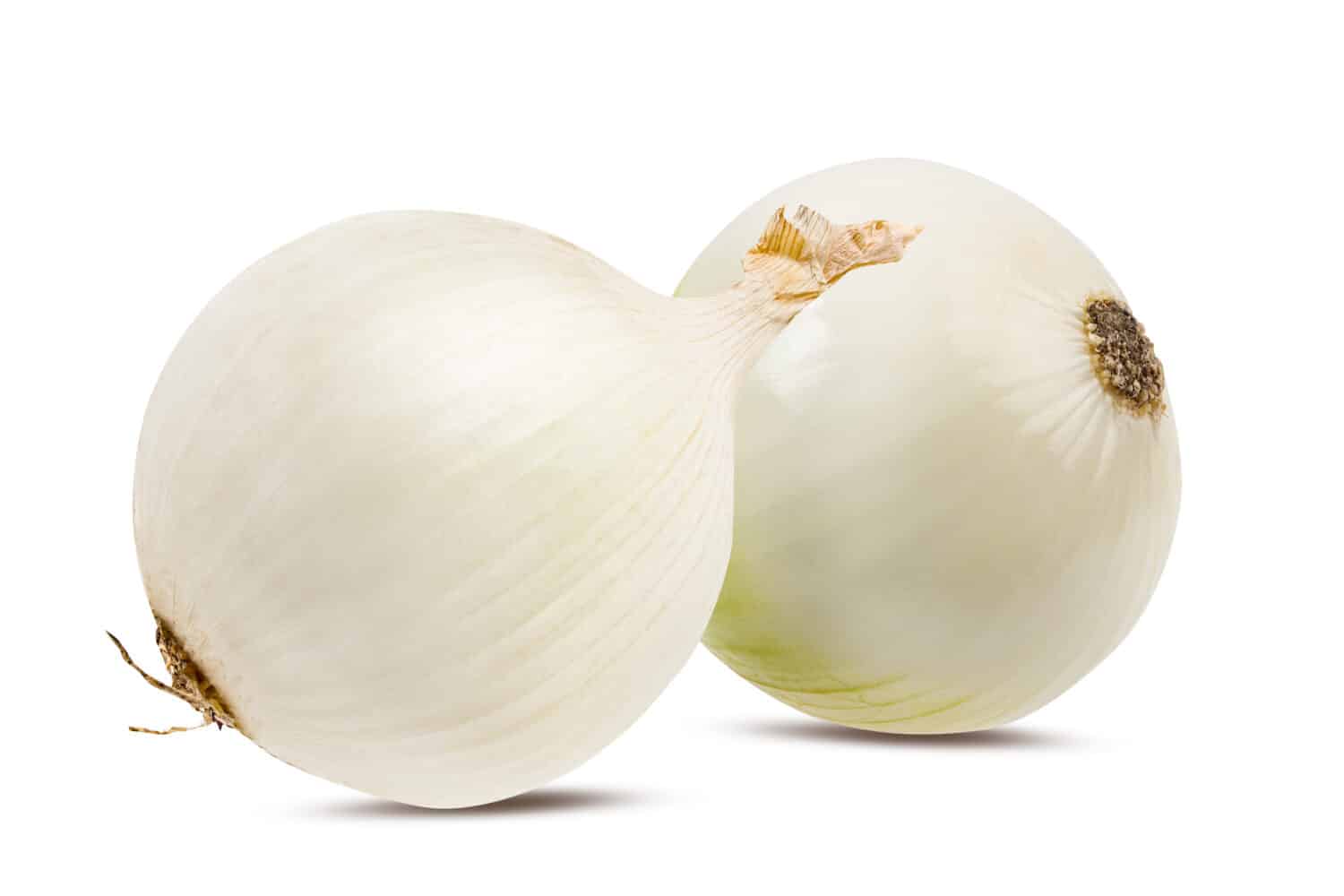
White onions are sweeter and milder in flavor.
©Kate Cuzko/Shutterstock.com
Known for their pure white skin and pleasantly mild flavor, white onions are a variant of dry onions. Their high sugar content, much like red onions, makes their shelf life relatively short.
The taste of white onions is milder and sweeter compared to their brown counterparts. This makes them a perfect addition to sandwiches, salads, or as an ingredient in fresh salsa – especially when used raw.
White onions are not just about flavor; they are also packed with numerous potential health benefits. They may act as antioxidants and potentially have antimicrobial properties. They could be beneficial for heart health and may even exhibit antiparasitic features. Furthermore, they might even contribute to maintaining healthy lungs and potentially help in managing blood sugar levels.
11. Daikon Radish
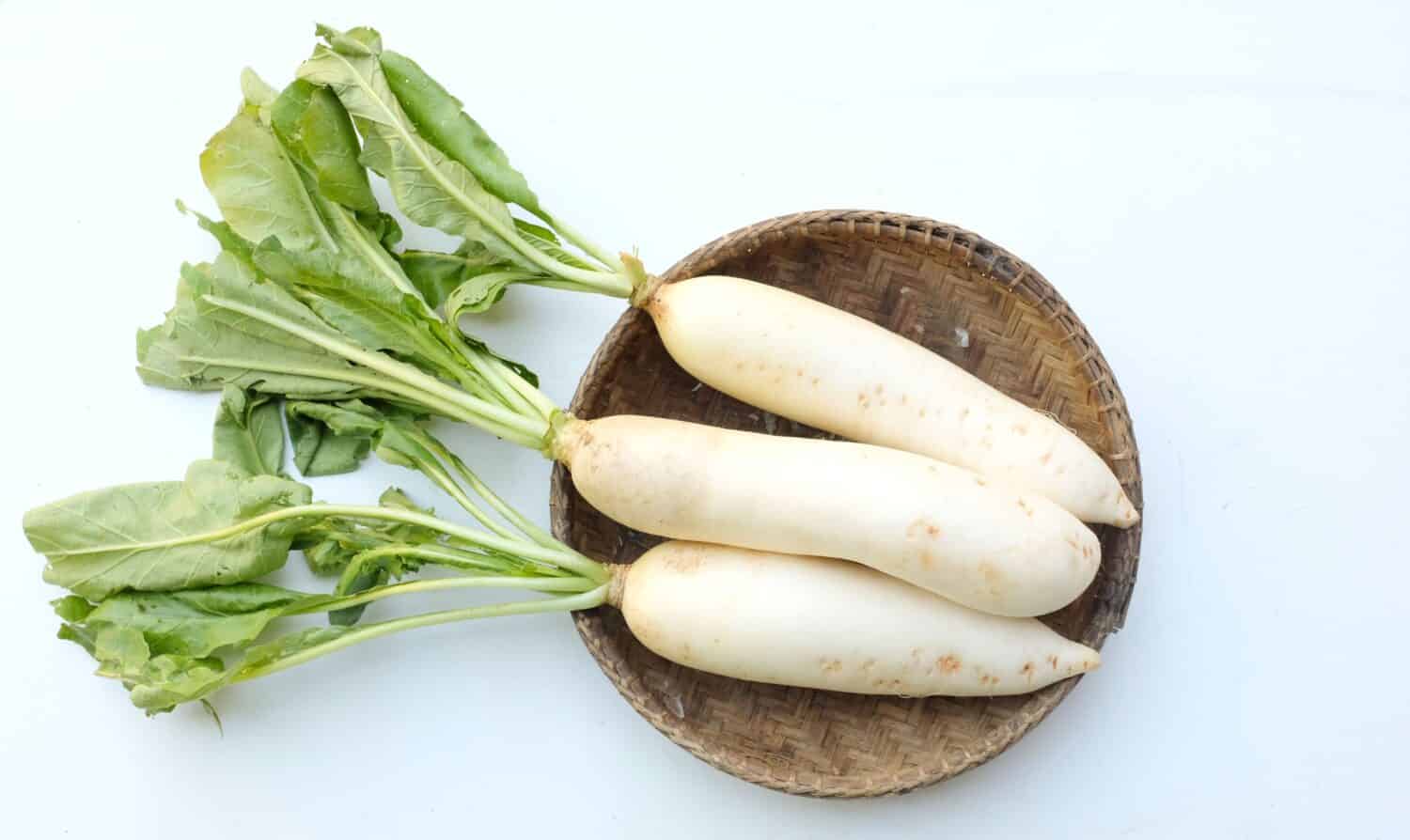
Also referred to as winter radish, the daikon radish is a root vegetable.
©NANTAWAN PATAMAROT/Shutterstock.com
Daikon, often referred to as winter radish, is a lengthy white root veggie predominantly cultivated in East and South Asia. With its sizable carrot-like shape, this variety of radishes is nutritious, crispy, and refreshing. It can also exhibit diverse textures and tastes based on the method of cooking.
It’s thought that the origin of daikon radishes can be traced back to the Mediterranean. These mild-tasting roots made their way to Asia through trade exchanges.
A myriad of plant compounds that may boost health and provide protection against specific diseases are found in daikon. Research in a lab setting has discovered that daikon has anti-inflammatory, cancer-fighting, and immunity-enhancing qualities.
When it comes to culinary uses, raw daikon is an excellent addition to salads and coleslaws or as a side dish during summer gatherings. When thinly sliced and pickled, it also makes a fantastic ingredient for sandwiches.
12. White Eggplant

Purple eggplants and white eggplants have very similar taste profiles.
©bergamont/Shutterstock.com
White eggplants encompass any variant of eggplants that display a white skin color. The range is extensive, from treasured heirloom types to more recently developed hybrids.
When it comes to flavor, white eggplants are less bitter, offering a creamier and more compact texture. Their taste is somewhat more subtle, yet these differences are generally minor. The taste of white eggplants is close enough to the purple equivalents that they can be swapped and used in any recipe that calls for eggplant.
It offers several nutrients, such as magnesium, which assists in maintaining healthy nerve function. This white vegetable also contains vitamin C, which bolsters the immune system, and other nutrients like manganese, vitamin K, niacin, and folate. Traditionally, in Ayurvedic practices, white eggplants have been used in different remedies for asthma.
Just like their purple relatives, white eggplants are best savored when cooked.
13. Navy Beans
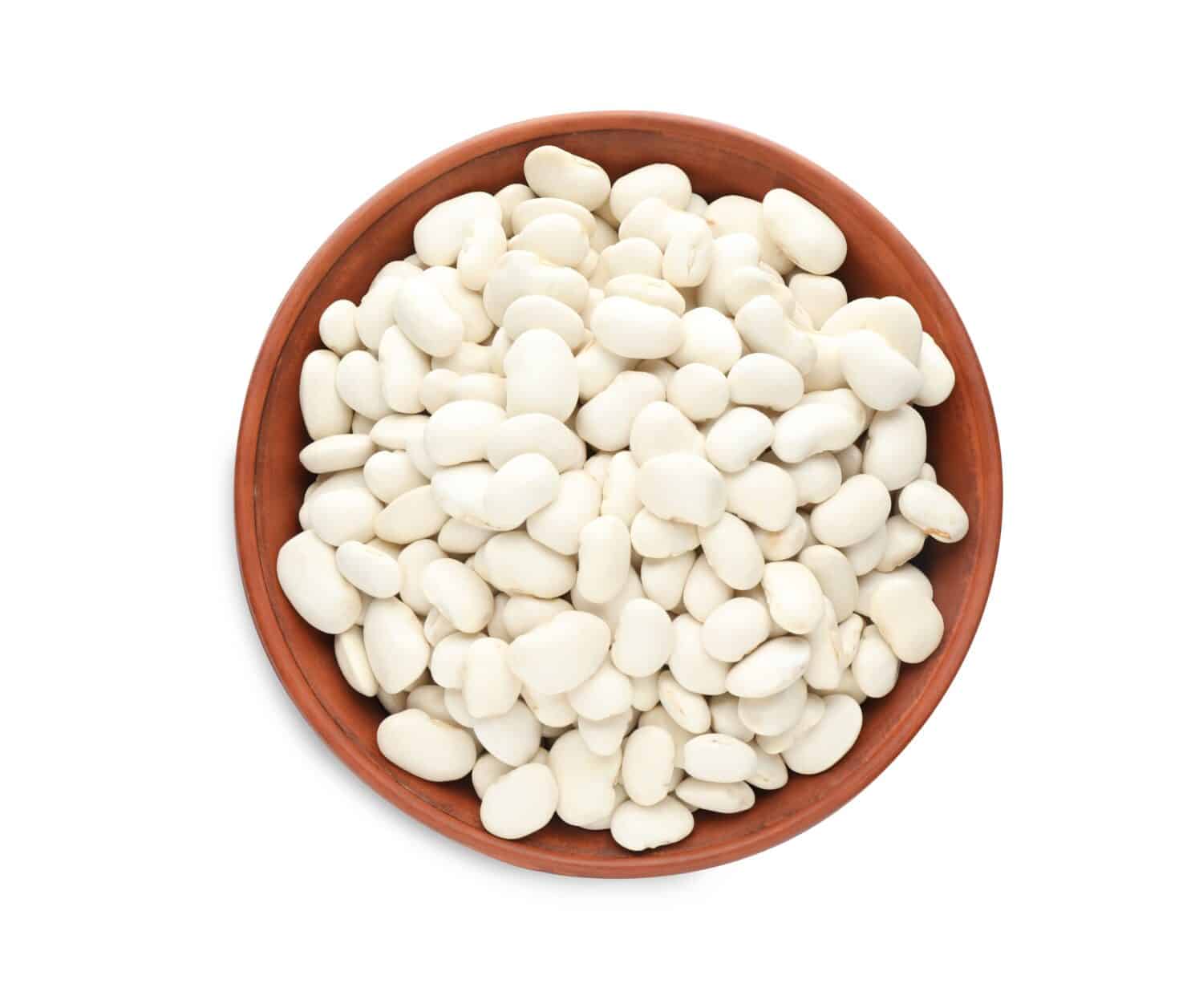
Navy beans are perfect in soups, salads, and casseroles.
©New Africa/Shutterstock.com
With their small, oval form and creamy white appearance, navy beans are a treat for the palate. Once cooked, their texture becomes beautifully soft and velvety, revealing their starchiness. These beans belong to the common bean family, with their roots traced back to ancient Peru.
They are nutritional powerhouses filled with essential nutrients like folate, magnesium, and potassium.
Their neutral yet comforting taste and smooth texture make navy beans an ideal ingredient in a wide array of dishes. They fit perfectly in nourishing soups, salads, and home-style casseroles. The term “navy beans” became popular as these beans were a crucial part of the U.S. Navy’s diet in the late 19th century.
Summary of White Vegetables
| Vegetable | Taste | Benefits | |
|---|---|---|---|
| 1. | Cannellini Beans | Nutty and earthy flavor | Fiber, iron, folate & magnesium |
| 2. | Cauliflower | Nutty and almost sweet | Fiber and antioxidants |
| 3. | Flageolet Beans | Mild and creamy | Fiber and carbohydrates |
| 4. | White Mushrooms | Umami flavor | Cancer-fighting properties |
| 5. | Turnip | Mild spicy | Vitamins C and A |
| 6. | White Asparagus | Sweet with a hint of bitterness | Vitamins E, C, and K |
| 7. | White Bell Pepper | Mild, sweet | Fiber, manganese, and potassium |
| 8. | White Corn | Nutty, mild, and sweet | Vitamin B and antioxidants |
| 9. | Garlic | Strong, pungent, and spicy | Allicin, zinc, and potassium |
| 10. | White Onion | Sightly sweet, and mild | Fiber and prebiotics |
| 11. | Daikon Radish | Slightly sweet, and mild | Minerals and antioxidants |
| 12. | White Eggplant | Slightly bitter, and creamy | Magnesium and potassium |
| 13. | Navy Beans | Nutty | Folate and manganese |
Thank you for reading! Have some feedback for us? Contact the AZ Animals editorial team.







